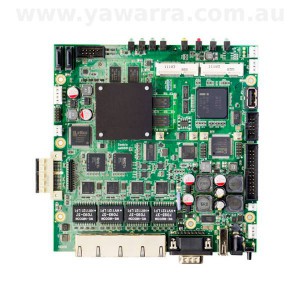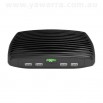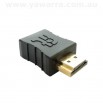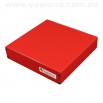 So, you want to install the super-awesome pfSense®
software on your shiny new net6501 board, but you’re having some troubles?
So, you want to install the super-awesome pfSense®
software on your shiny new net6501 board, but you’re having some troubles?
This might be because the net6501 is a newer device, which requires write caching and DMA to be enabled in order to be able to access the mSATA drive correctly.
If DMA and write caching are not enabled, the BSD boot loader will most likely hang during boot.
Follow along step-by-step as we show you how to install the pfSense® software onto a net6501 board, using either:
- The standard pfSense® embedded image
- Our Rident™ software image, which is based on the pfSense® software with enhancements so it works “out of the box” on the net6501
Installing the pfSense® embedded image
Step 1. Download the image
Go to the pfSense® website.
Click the big red ‘Download’ button.
Click on the link in the section titled ‘New Installs’ that takes you to a form titled ‘Download Full Install’.
Under ‘Which image do I need?’, select the following options:
- Computer architecture: i386 (32-bit)
- Platform: Embedded (NanoBSD)
- Console: Serial
- CF card size: To suit your media
Notes
- For the CF card size option, choose the size that matches your media.
- If your media is above 4GB in size, just use the 4GB image.
- Some media (especially SanDisk) claim certain sizes but use “small” GB (ie 1000K = 1MB and 1000MB = 1GB), so the image may not fit onto your media, even though they are supposed to be the same size. If this happens, just use the next image size down.
Once you have made your selection, a list of mirrors will appear.
Choose the closest one to you (or a random one) and save the image file to your local computer.
Step 2. Get the image onto the net6501
Copy the pfSense® software image onto your mSATA drive.
Using Linux
If you’re using a Linux machine to copy the image, use dd with the following command.
gunzip -c pfSense-2.1.3-RELEASE-4g-i386-nanobsd.img.gz | dd of=/dev/sdc bs=4M
Important
- Modify the file name to suit the image file you have downloaded.
- /dev/sdc will vary depending on how your system is set up. It could be /dev/sdb, or /dev/sdd, or /dev/sde
To find out type
fdisk -l
This will give you a list of the disks your system knows about.
Look for one that is the same size as your mSATA drive.
Using Windows
If you’re using a Windows machine to copy the image, use phydiskwrite with the following command.
physdiskwrite -u pfSense-2.1.3-RELEASE-4g-i386-nanobsd.img.gz
Important: Modify the file name to suit the image file you have downloaded.
Insert your mSATA drive into the net6501 board.
Step 3. Boot the net6501 and change the console speed
Connect to the serial console on the net6501 and set your terminal speed to 19200 baud.
Apply power to the net6501.
During the POST (power on self test), press Control + P
At the prompt (>) type
set conspeed 9600
Then type
reboot
While the net6501 is rebooting (you’ll see garbage on the screen), turn off the power to the net6501.
Change your terminal speed to 9600 baud.
Apply power to the net6501 again.
Wait for the following text to appear
Booting [/boot/kernel/kernel]
Press CTL+C (Control + C) to interrupt loading and get the boot loader prompt.
- Interrupting the boot loader at the right point is literally hit and miss.
- So if your box continues to boot, power it off and try again.
Step 4. Get the pfSense® software to boot
At the prompt (OK), type
set hw.ata.atapi_dma="1"
set hw.ata.ata_dma="1"
set hw.ata.wc="1"
then type
boot
Wait for the box to go through the boot process, until you see the following message
Default interfaces not found -- Running interface assignment option.
Step 5. Assign interfaces
You’ll need to assign interfaces at this point.
When it asks you if you want to set up VLANs, type ‘n’.
And then assign the interfaces as follows
- WAN to em1
- LAN to em0
- OPT1 to em2
- OPT2 to em3
When it asks if you want to proceed, type ‘y’.
The pfSense® system should now boot correctly, and take you to the usual console menu.
Step 6. Create local config file
Before you do anything else, you need to create a loader.conf.local file to avoid the net6501 from hanging the next time that you reboot.
This file will contain the necessary code to allow the pfSense® system to boot correctly without needing intervention from you.
Note
- There are actually two copies of the pfSense® software in the image, so you will need to create this file on both slices.
To create this config file, you have two choices:
- Use the webGUI
- Use the command line and vi
Option 1 – Create config file via the webGUI
Slice 1
Log into the webGUI (at 192.168.1.1).
Go to Diagnostics > Edit File
In the ‘Save/Load from path’, type
/boot/loader.conf.local
Then in the box below type
hw.ata.atapi_dma="1"
hw.ata.ata_dma="1"
hw.ata.wc="1"
and click ‘Save’.
Halt the pfSense® system and prepare to configure Slice 2.
Slice 2
Apply power to the net6501.
When it says
1 pfSense
2 pfSense
F6 PXE
Boot: 1
Press 2 to load the second slice.
Interrupt the boot loader with CTL+C as before (Step 3).
The boot loader automatically remembers which slice you loaded last time, so it will load Slice 2 this time and you can repeat Step 4.
You don’t need to repeat Step 5 because the interfaces have already been assigned.
Go back to the instructions for Slice 1 (Step 6) and repeat the process to create a loader.conf.local via the webGUI for Slice 2.
You can switch back to Slice 1 using the above process, or just keep using Slice 2 – they’re identical and it doesn’t matter which one you use.
We always configure our boxes to use Slice 1 by default to minimise confusion.
Option 2 – Create config file via the command line
From the console menu, press 8 to get a shell prompt.
To put the disk into read-write mode, type
/etc/rc.conf_mount_rw
To create the config file and begin editing it, type
vi /boot/loader.conf.local
Press ‘i’ to get into insert mode.
To enable DMA and write caching, type
hw.ata.atapi_dma="1"
hw.ata.ata_dma="1"
hw.ata.wc="1"
Press escape to get out of insert mode.
Type :wq to write the file and quit.
Go out of read-write mode by typing
/etc/rc.conf_mount_ro
Mount the second slice, which has a second copy of the pfSense® software, by typing
mount /dev/ufs/pfsense1 /mnt
Copy the file you created previously, by typing
cp /boot/loader.conf.local /mnt/boot/loader.conf.local
Unmount the second slice by typing
umount /mnt
To exit the shell, type
exit
And you should now be back at the console menu.
Step 7. Start using the pfSense® software
Your pfSense® system is now ready to configure and use.
From now on, whichever slice you boot into, it should load without hanging, and your changes will persist across upgrades.
Installing the Yawarra Rident embedded image
If you’d like an easier way, you can download and use our Rident™ images, which are based on the pfSense® software and have these changes already made for you:
- The ethernet ports are pre-assigned
- It doesn’t hang during boot (it already has the loader.conf.local file on both slices)
- It resets to our factory defaults (and you can set set your own defaults too)
The Yawarra Rident™ firewall and router software for embedded servers, is a modified version of the pfSense® software, optimised to suit our hardware.
How to install our Rident image on the net6501
Download the embedded image from our operating system images page.
Save the image file to your local hard drive.
Copy the Rident™ image onto your mSATA drive.
Using Linux
If you’re using a Linux machine to copy the image, use dd with the following command.
gunzip -c rident213_4GB_net6501.img.gz | dd of=/dev/sdc bs=4M
Important
- Modify the file name to suit the image file you have downloaded.
- /dev/sdc will vary depending on how your system is set up. It could be /dev/sdb, or /dev/sdd, or /dev/sde
To find out type
fdisk -l
This will give you a list of the disks your system knows about.
Look for one that is the same size as your mSATA drive.
Using Windows
If you’re using a Windows machine to copy the image, use phydiskwrite with the following command.
physdiskwrite -u rident213_4GB_net6501.img.gz
Important: Modify the file name to suit the image file you have downloaded.
Insert your mSATA drive into the net6501 board.
Apply power to the net6501 and either connect to the serial console (at 9600 baud) or go straight to configuring Rident™ via the webGUI at 192.168.1.1
How easy was that?
Or get us to do it
If that all sounds too hard, then you can always get us to pre-install Rident™ for you when you buy an net6501 server from us.
Have fun playing with the pfSense® software on your net6501!
Want more great articles like this?
Sign up for email updates and get them delivered straight to your inbox.
We'll also donate $5 to Voyage Linux, to support the ongoing development of this fantastic software.
Sign me up!



